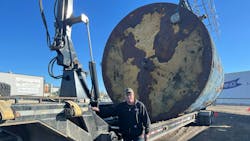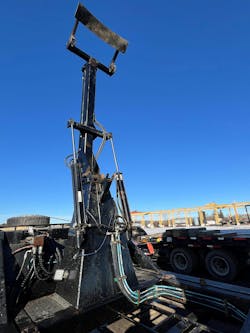Extreme operations: Building trucks for winter wilderness
For more on design:
Very few things, including bitter, blasting, arctic-cold temperatures, can put a stop to Northland Logistics’ delivering for its customers. Just ask Roger Keddy, shop foreman, and the rest of the team, which provides tank moving and heavy hauling services in the harsh conditions of Northern Alberta, Canada. The Northland team gives a whole new meaning to the phrase “rain or shine.”
Northland Logistics transports oversize, overweight, and difficult loads, which can include everything from oil field equipment to agriculture equipment, across British Columbia, Alberta, Saskatchewan, and Manitoba, Canada.
The company’s busiest season is November through March, when the ground is frozen solid enough for heavy trucks to reach hard-to-get-to terrain, and when temperatures can dip as low as -55 degrees C.
In such extreme temperatures it’s not just people that get cold, it’s the equipment, too. In fact, in the winter of 2023, Northland Logistics spent upward of $50,000 just on replacement parts for hydraulic hoses that were cracked, leaking, and ultimately failed on the job, which causes a slew of problems—and safety hazards.
In addition to the environmental stressors of the Canadian bush country, Northland’s equipment operates in and around rugged terrain, where hydraulic hoses are exposed to rough debris, rocks, branches, and more during hauling. Previous hose failures led to significant downtime, costly replacements, and safety hazards for employees. A single hose break could mean up to an eight-hour delay, with incurred costs skyrocketing due to equipment downtime and required cleanups, including vacuum trucks costing upwards of $4,000 per incident.
Last winter, Keddy decided to make a switch to more durable and reliable hydraulic hoses.
Hoses & crimping system
When Rory Carpenter at Red-L Distributors, a leading hydraulic and industrial hose distributor in Western Canada, received a call from Keddy, he had just the hose for the job: the Continental Arctic hydraulic hose, which is known for its durability and extreme temperature resistance.
“Continental’s Arctic hoses are great for use in the bush because they can withstand incredibly extreme temperatures and are more durable because of the special coating on the outside of the hoses,” said Carpenter. “I knew these hoses would be right for this job.”
In addition to making the switch to the more durable hoses, the Northland team also purchased a Continental crimper to make proper fittings.
The Arctic hoses, engineered to handle temperatures as low as -70 degrees C, proved to be a game-changer for the company and the employees working in the field. Not only did the hoses withstand the frigid winter conditions, but their outer coating and robust fittings prevented leaks and failures, even under constant use in hydraulic systems on flatbeds, hoists, and water trucks.
“The guys out in the bush can’t say enough good things about the way the season went, and I attribute a lot of that to the success of the Arctic hoses and the crimper,” said Keddy. “Knowing you have a decent hose on your equipment is worth a lot.”
Increased performance, decreased cost
In addition to making the field teams’ work more seamless, the switch to more durable Arctic hoses delivered measurable results in both cost and performance.
For the first time in company history, the Northland team did not experience a single hose failure due to cold temperatures. Previously, hose failures were a common and costly occurrence.
“Before switching to Continental, we were spending approximately $50,000 per season on hose replacements,” said Keddy. “With the Arctic hoses, we haven’t had to replace a single hose due to failure—resulting in massive savings on parts and labor. Previously, if a hose cracked or failed, my guys would have to drive out of the bush for up to four hours one way to get to a dealer to repair the hose and then drive back.
“The entire process would halt operations, essentially losing an entire day of work. With the Arctic hoses, we have completely eliminated this as a barrier, saving us hours of time and money.”
In addition to the hoses themselves, investment in the crimper yielded big dividends. Crimp fittings held firm under high pressure (4,000–5,000 psi), ensuring no leaks and preventing hazardous hydraulic fluid exposure and potential harm to employees.
Furthermore, in the rare instance a hose needed replacing for cosmetic reasons, field teams were able to complete the task in about 15 minutes using the intuitive new crimper.
Previously, repairs could take a full day, leading to operational delays and lost revenue.
“Our initial $18,000 investment in the crimper paid off within one year, saving the company thousands in downtime, repairs, and emergency response,” Keddy said.
Even with such measurable cost and performance benefits, perhaps the biggest benefit of switching to the more durable and weather-resistant hose is the safety it provides workers in the field.
“Hoses that leak or rupture under high pressure create serious safety concerns and can even result in death,” said Keddy. “Our employees in the bush are pleased with the switch to these hoses because they know they can work more productively without having to crawl under trucks to make repairs in the bitter cold, and they can work with greater confidence in their safety. At the end of the day, that’s the greatest value of all.”
Laszlo Dobo is the head of Product Management for Hydraulic Solutions at ContiTech USA. Dobo brings 15 years of diverse experience at Continental, where he has held roles in operations, sales, and product management focused on fluid handling solutions.
About the Author
Laszlo Dobo
Head of Product Management
Laszlo Dobo is the head of Product Management for Hydraulic Solutions at ContiTech USA. Dobo brings 15 years of diverse experience at Continental, where he has held roles in operations, sales, and product management focused on fluid handling solutions.


